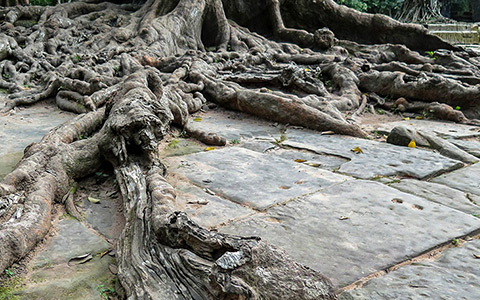
Invasive tree roots can destroy your turf, buckle concrete, and quickly become a very costly nuisance. Knowing which tree species to avoid planting and how to deal with aggressive trees already on your property will save you time, money, and stress.
72tree.com gathered information on invasive tree roots, the damages they cause, how to stop them, and which species you should not plant.
Invasive tree roots quickly grow in search of water and nutrients, finding their way under walkways, driveways, building foundations, sidewalks, water lines, sewer pipes, etc. As these roots thicken, they can cause these structures to fracture and buckle.
A common trait of invasive plants and tree roots is that they are fast-growing. Once these roots find a water source, they take hold and continue spreading to find more water sources.
Once invasive tree roots spread across your yard or landscape, all they need is a water source. When that water source is tapped into, the roots thicken and tear up your turf, while breaking through nearly everything they have grown beneath.
Among the most expensive damages, invasive tree roots can cause: when they grow under the foundation of your home.
Note: These roots don’t just break through concrete or asphalt, they can cause the earth surrounding them to heave upward.

Read 72tree.com/tree-roots-buckling-concrete-driveway/ to uncover the devastation these roots can cause and ways to repair the damage they cause.
Don’t plant tree species with invasive roots. If you inherited these trees with your property or were ill-advised when you purchased and planted a tree, here are some of the measures you can take to slow these roots down:
1. Install root barriers to a depth of 18 to 24 inches (the majority of tree roots are found within the top 18 inches of soil). You can install these barriers around young trees or around structures to stop or divert the direction of the roots. When installing barriers, allow enough space for tree roots to form a stable root plate. The root plate generally surrounds the trunk and extends to the tree’s drip line.
2. Root pruning is an option that should be done by an arborist. Pruning tree roots can leave the tree vulnerable to disease and infestation.
3. After planting a tree, provide it with frequent deep waterings to encourage its roots to grow deeper.
4. Plant trees in locations where they can achieve their full growth potential without interfering with structures and landscape features.
5. Make sure the tree you are planting is appropriate for your hardiness zone. Planting outside the tree’s zone may trigger its roots to become aggressive to supply it with enough moisture.
6. Often times, the only solution for invasive root problems is to have the tree removed and the stump ground.

The following is a brief list of tree species that have displayed invasive root tendencies, are high-maintenance, and short-lived (when compared to similar non-invasive species):
• Aspen (Populus)
• Eastern Cottonwood (Populus deltoides)
• Empress or Princess Tree (Paulownia tomentosa)
• English Hawthorn (Crataegus monogyna)
• English Holly (Ilex aquifolium)
• English Laurel (Prunus laurocerasus)
• Golden Chain Tree (Laburnum)
• Horse Chestnut (Aesculus hippocastanum)
• Mimosa (Albizia julibrissin)
• Norway Maple (Acer platanoides)
• Saltcedar (Tamarix ramosissima)
• Siberian elm (Ulmus pumila)
• Silver Maple (Acer saccharinum)
• Sweet Cherry (Prunus avium)
• Sweet Gum (Liquidambar styraciflua)
• Sycamore (Platanus occidentalis)
• Sycamore Maple (Acer pseudoplatanus)
• Tree of Heaven (Ailanthus altissima)
• Weeping Willow (Salix babylonica)
• White Mulberry (Morus alba)
• White Poplar (Populus alba)
Many of the trees listed above can grow to enormous proportions (in height and width) and likely are not appropriate for small to medium-sized yards and landscapes.
Regardless of the species, you would like to plant, do your homework on how it grows, where it grows, and problems others have had with it. You can also hire an arborist to assess your yard or landscape before planting the tree. This will help you give the tree a healthy beginning.
Read more about planting trees by visiting 72tree.com/tree-planting-guide/
In this article, you discovered what invasive tree roots are, the damage they are capable of, what you can do to stop them, and several of the species to avoid.
By addressing invasive tree roots as early as possible, you can avoid significant damages to your property, water supply, sewage line, and your home’s foundation.
When you allow invasive tree roots to grow unchecked, you are inviting them to tear up your turf, destroy structures, and upheave the earth they grow in.
Sources:
mortonarb.org/trees-plants/tree-and-plant-advice/horticulture-care/tree-root-problems
selectree.calpoly.edu/right-tree-right-place#invasive
aces.nmsu.edu/ces/yard/2008/091108.html
extension.tennessee.edu/publications/Documents/SP628.pdf